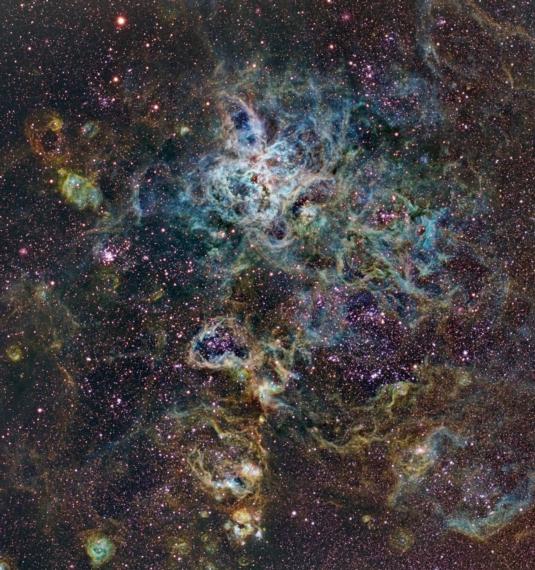The Tarantula and Friends in Narrow Band
 Click Image for full size view Warning: Full size images can be very large |
By |
Catalog |
Obj Type |
Location |
Date Taken: |
Mazlin |
NGC 2070 |
Nebula |
CTIO, Chile |
11-30-2008 |
Description |
||||
The Tarantula Nebula in Dorado, the goldfish constellation, is the most active star forming area in or around the Milky Way. At 180,000 light years distant, this nebula is extremely luminous -- in fact, if it were only 1500 light years distant (ie the Orion Nebula), it would cast shadows on the earth at night! This region also gave birth to the closest supernova to earth since man has gazed starward with a telescope -- Supernova 1987A. Here is the first light image from the SBIG STL11000, installed on the Takahashi FSQ at CTIO during our trip to Chile in October 2008. It is a narrowband version of the field containing the Tarantula nebula, cropped to approximately the same field as the broadband version we did with the ST10 last year. This image also marks the first full (SII-Ha-OIII) narrowband image we have completed, though the site contains many other images enhanced with Ha data, and a few (Keyhole & Eagle Nebulae) that were done using a bicolor (Ha & OIII) approach. Click here to see the broadband version. Click here to see some images from the Chile trip. |
||||
Technical Details |
||||
Exposure Time: |
Ha 9 hours, OIII 5 hours, SII 4 hours -- all 1x1 | |||
Camera: |
SBIG STL-11000M | |||
Telescope: |
Takahashi FSQ106N | |||
Mount: |
Software Bisque Paramount ME | |||
© 2024 Mazlin Used with permission, No reproduction of these images are permitted without written approval from Mazlin. |
||||
